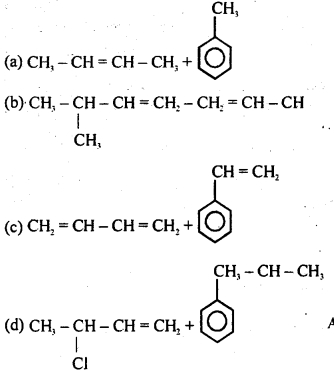MCQ Questions for Class 12 Chemistry Chapter 15 Polymers with Answers
Question 1.
Bakelite is an example of
(a) elastomer
(b) fibre
(c) thermoplastic
(d) thermosetting
Answer
Answer: (d) thermosetting
Question 2.
Arrange the following polymers is an increasing order of intenqolecular forces: fibre, plastic, elastomer
(a) Elastomer < Fibre < Plastic
(b) Elastomer < Plastic < Fibre
(c) Plastic < Elastomer < Fibre
(d) Fibre < Elastomer < Plastic
Answer
Answer: (b) Elastomer < Plastic < Fibre
Question 3.
The correct structure of monomers of buna-S is

Answer
Answer: (c)
Question 4.
The S in buna-S refers to
(a) Sulphur
(b) Styrene
(c) Sodium
(d) Salicylate
Answer
Answer: (b) Styrene
Question 5.
Identify the type of polymer
(i) -A-A-A-A-A-A-
(ii) -A-B-B-A-A-A-B-A-
(a) (i) Homopolymer, (ii) Copolymer
(b) (i) Natural polymer, (ii) Synthetic polymer
(c) (i) Linear polymer, (ii) Branched polymer
(d) (i) Fibre, (ii) Elastomer
Answer
Answer: (a) (i) Homopolymer, (ii) Copolymer
Question 6.
Which of the following are thermoplastic polymers?
(a) Polythene, urea-formaldehyde, polyvinyls
(b) Bakelite, polythene, polystyrene
(c) Polythene, polystyrene, polyvinyls
(d) Urea-formaldehyde, polystyrene, bakelite
Answer
Answer: (c) Polythene, polystyrene, polyvinyls
Question 7.
Glycogen, anaturally occuring polymer stored in animals is a
(a) monosaccharide
(b) disaccharide
(c) trisaccharide
(d) polysaccharide
Answer
Answer: (d) polysaccharide
Question 8.
Nylon 6, 6 is obtained by condensation polymerisation of
(a) adipic acid and ethylene glycol
(b) adipic acid and hexamethylenediamine
(c) terephthalic acid and ethylene glycol
(d) adipic acid and phenol
Answer
Answer: (b) adipic acid and hexamethylenediamine
Question 9.
Terylerte is a condensation polymer of ethylene glycol and
(a) benzoic acid
(b) phthalic acid
(c) dimethyl terephthalate
(d) salicylic acid
Answer
Answer: (c) dimethyl terephthalate
Question 10.
Natural rubber is a polymer of
(a) 1, 1-dimethylbufadiene
(b) 2-methyl-1, 3-rbutadiene
(c) 2-chlorobuta-1, 3-diene
(d) 2-chlorobut-2-ene
Answer
Answer: (b) 2-methyl-1, 3rbutadiene
Question 11.
Heating rubber with sulphur is known as
(a) galvanisation
(b) bessemerisation
(c) vulcanisation
(d) sulphonation
Answer
Answer: (c) vulcanisation
Question 12.
Dacron is an example of
(a) polyamides
(b) polypropenes
(c) polyacrylnitrfle
(d) polyesters
Answer
Answer: (d) polyesters
Question 13.
Which of the following is a condensation polymer?
(a) Teflon
(b) PVC
(c) Polyester
(d) Neoprene
Answer
Answer: (c) Polyester
Question 14.
Which of the following polymers does not involve cross-linkages?
(a) Vulcanised rubber
(b) Bakelite
(c) Melamine
(d) Teflon
Answer
Answer: (d) Teflon
Question 15.
Composition of Ziegler-Natta catalyst is
(a) (Et3)3Al.TiCl2
(b) (Me)3Al.TiCl2
(c) (Et)3Al.TiCl4
(d) (Et)3Al.PtCl4
Answer
Answer: (c) (Et)3Al.TiCl4
Question 16.
Which of the following is not an example of addition polymer?
(a) Polythene
(b) Polystyrene
(c) Neoprene
(d) Nylon 6,6
Answer
Answer: (d) Nylon 6,6
Question 17.
Teflon and neoprene are the examples of
(a) copolymers
(b) monomers
(c) homopolymers
(d) condensation polymers
Answer
Answer: (c) homopolymers
Question 18.
Which of the following sets contains only addition polymers?
(a) Polyethylene, polypropylene, terylene
(b) Polyethylene, PVC, acrilan
(c) Buna-S, nylon, polybutadiene
(d) Bakelite, PVC, polyethylene
Answer
Answer: (b) Polyethylene, PVC, acrilan
Question 19.
Which among the following is a cross-linked polymer?
(a) Polyesters
(b) Glycogens
(c) Melamine-formaldehyde
(d) Polyvinyl chloride
Answer
Answer: (c) Melamine-formaldehyde
Question 20.
Synthetic polymer prepared by using caprolactam is known as
(a) terylene
(b) teflon
(c) nylon 6
(d) neoprene
Answer
Answer: (c) nylon 6
Question 21.
Polymer which has amide linkage is
(a) nylon-6, 6
(b) terylene
(c) teflon
(d) bakelite
Answer
Answer: (a) nylon-6, 6
Question 22.
Which of the following is not an example of rubber?
(a) Polychloroprene
(b) Buna-N
(c) Butadiene-styrene copolymer
(d) Polyacrylonitrile
Answer
Answer: (d) Polyacrylonitrile
Question 23.
Which of the following polymers does not have vinylic monomer units?
(a) Acrilan
(b) Nylon
(c) Polystyrene
(d) Neoprene
Answer
Answer: (b) Nylon
Question 24.
cis-Polyisoprene possesses elastic property because
(a) It is soft and soluble in non-polar solvent
(b) It is unsaturated and porous
(c) It has a coiled structure and chains held together by weak van der waals forces
(d) It has fibrous structure and reactive sites at various double bonds
Answer
Answer: (c) It has a coiled structure and chains held together by weak van der waals forces
Question 25.
The monomers used in addition polymerisation through free radical should be very pure because
(a) the traces of impurities act like inhibitors resulting in short chain polymers
(b) the impurities result in formation of different products
(c) the polymer formed is impure
(d) catalyst does not function in presence of impurities
Answer
Answer: (a) the traces of impurities act like inhibitors resulting in short chain polymers
0 Comments